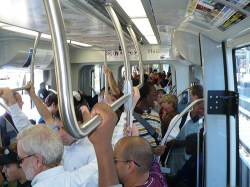 No justice, no ride to work! The vast majority of transit systems in the U.S. have cut service, raised fares, or both over the last two years, affecting those who rely on public transportation especially hard.
No justice, no ride to work! The vast majority of transit systems in the U.S. have cut service, raised fares, or both over the last two years, affecting those who rely on public transportation especially hard.
An article in the current issue of the Boston Review outlines the struggle for more justice and more buses:
For millions of American families, the commute to work is more than stressful: it can also be cripplingly costly. While the average family spends around 19 percent of its budget getting around, very low-income families (defined as families who make less than half of an area’s median income) can see as much as 55 percent of their earnings eaten up by transportation costs, according to a report by the Center for Transit-Oriented Development. …
Nationwide about 80 cents out of every federal transportation dollar goes toward highways—used disproportionately by more affluent drivers — and only 20 cents goes toward mass transit systems, which are heavily used by people of color and by lower-income workers. When it’s time to distribute that 20 percent, regional authorities often favor light-rail systems for suburban commuters over bus lines for city riders.
Some hope, though: A few cities have managed to wrest money away from the ‘burbs and back to the urbs by filing lawsuits claiming civil rights violations.
That tactic may not work for New Yorkers, though, who are about to see yet another fare hike, their fourth in five years — and it’s not because transit workers are getting a raise. Here, New Yorkers campaigning against fare hikes explain how debt service has increased train costs.
If there’s one thing the status quo has no answer for, it’s digging out of debt. Sorry, New York.



